Spy games, politics... and the War in Ukraine Update (Oct. 28, 2024)
Greetings and salutations, friends, perusers and (obvious) bots.
Just thought I'd throw that in to get off to a good start on a Monday... but in fact the past week has been tumultuous with regard to CEE politics, spy games and intrigues. And then of course, there is the war in Ukraine.
And we are going to jump right into it, but first, a quick note with regard to Georgia. I recently noted a blog in which a Georgian noted that those elections were thrown, and that the youth vote--which was remarkable--was betrayed by voting corruption the throwing of the election apparently geared to make Georgia a Russian puppet state.
While I do not focus on Georgia, the above is a hugely true and provocative point. I should state also that, yes, we do have sources out that direction and I do believe that a "constitutional coup" has taken place. In short, the opposition has been screwed, the goal of joining the EU, far-fetched that it was, has been stolen, but most importantly likely so has the belief of youth in a democracy in that state.
Georgia is now on track to become Belarus. For many in the West... the reality is that it is so far beyond their horizon that it might as well be the moon. This is sheer ignorance. The overturning of elections anywhere in the world is evil.
Ok, enough preaching, but if you would like to catch up, here is a quick news reel:
Now off to local intrigue, arrests and the like. Not featured here, however, are the upcoming Bulgarian elections. Hang on through Halloween for that. Things will get interesting down there (and Russian meddling is already obvious).
Otherwise, here are your regional highlights.
And the now infamous War in Ukraine Update is at the end.
Albania
Say what you want, but Albania is not a country where you just let bygones be bygones—as Albanian anti-corruption police (SPAK) proved yet again with the arrest of former Albanian Prime Minister Ilir Meta this week.
Meta is accused of money laundering; of failing to file required asset documentation and of corruption. Meta and his part, the Albanian Freedom Party, have denied the charges, called them politically motivated, etc.
Which is what politicians always say.
That said, this is not the first time he has made the news in negative fashion, and it is rather hard to give him much benefit of the doubt.
Meanwhile, some have claimed that digging back through the past (some allegations against Meta go back, perhaps even a decade) will create nothing more than extreme division. This may be true. On the other hand, Central European countries that went further with regard to digging up past secret service links and corrupt activities handed down by communist systems seem to have done better with regard to closure.
More or less.
Czech(ia)
A story of the week—which rather illustrates the power of the… erm… rich and powerful—can be found here at the Slovak Spectator:
In short, former Czech Prime Minister (and Teflon politician on the rebound) Andrey Babis long ago lost his battles with Slovakia and the Slovak Nation’s Memory Institute over his allegedly collaboration with the Czechoslovak state security (StB).
So when that didn’t work, he sued the Slovak Ministry of the Interior. As if that would work.
Well, surprise, surprise, Slovak Minister of the Interior Matus Sutaj agreed to a settlement that states that Babis was registered against his will under the pseudonym Bures.
Ta da.
But don’t laugh. Other countries in CEE have seen the same thing. Instead, read the story on the link… and weep.
Estonia
If Yours Truly seemed nostalgic last week for the good old mafia days, perhaps sentimental morbidity was misplaced, as they are hardly behind us. The Estonian weekly Eesti Ekspress has not revealed that a kidnapping team visited Estonia in July and attempted to grab none other than Australian on-line gambling/crypto entrepreneur Tim Heath, with the foreign gang waiting at his apartment disguised as painters.
That said, Heath, who is the founder of the Yolo group, just happens to be a rough and tough Australian, and he fought back well enough to foil the attack.
The weekly also was said to have rented property where Heath was supposed to have been held—likely for ransom. The key suspects have not been named, but they have been extradited to Estonia after having made the mistake of using a Bolt rental car, which enabled identification and subsequent arrest.
Montenegro
No snapshot of local intrigue would be complete without a mention of Montenegro and… yes, South Korean founder of Terraform Labs, now indicted and wanted for extradition by the US, Singapore and South Korea because somewhere along the way he managed to wipe out no less than 45 bln of other people’s money.
Yes, only a back in September did Yours Truly mention that extradition to the US had been postponed against a rather controversial background that included alleged secret meetings with Montenegrin Prime Minister Milojko S., with other ministers and past minister claiming that Milojko S. wanted to avoid Do Kwon’s extradition--to the US—at least, as this could prompt a wider inquiry.
But if you thought that was intriguing… hold on to your hats.
It turns out that the arrest of Do Kwon may not have been quite as simple as first portrayed. The media (and most everyone else) was led to believe that he fled from Serbia to Montenegro and was snagged at the border at one point with a false passport.
Now allegations have surfaced that the Serbian government—which admittedly is always being criticized for… something—simply saw no reason to allow Do Kwon to hide in that country and thus again raise the ire of the US government.
So someone in Serbia did the simple thing, supposedly, which is that said someone who shall not be named (but whose last name probably beings with “V”) tasked the secret service to drive the fugitive former crypto king to the border.
Yet that is only the beginning. When Do Kwon was incarcerated apparently Montenegrin police failed to find or even search for electronic devices (as in laptops, possibly), and neither did they determine or force him to turn over the login details to his crypto wallet or wallets.
This meant that for some three months Do Kwon actually had access to his accounts… and yes, allegedly he used these to make money .
But yes, there is even more.
Quite some time back (if Yours Truly remembers correctly, this is reported in the magazine editions of The Corners that can still be found on this website), that back in September 2023 a gang of criminals dug a 30 meter tunnel into the evidence room of the primary courthouse in Podgorica.
How that happened without triggering any kind of security mechanism was quite the scandal. And there were questions as to whether the evidence room had been tampered with or whether key cases—including those linked to the Kavac and Skaljari mafias could have been impacted.
In short, the public was led to believe that this was not the case—that the would-be thieves were likely surprised or scared off during the heist.
Yet, as tends to be the case in Montenegro, this was not entirely the truth, and now—more than a year after the fact—the Balkan News Network investigative site has revealed that in fact weapons and narcotics were in fact stolen. And while there have been some arrests… nobody yet has revealed who was truly behind the crime.
But wait… we were talking about Do Kwon, and yes there is still more intrigue. Reportedly, one of the devices in police possession from the get go (more or less) was Do Kwon’s mobile phone.
And what happened when the tunnel was discovered?
The phone clicked on. And possibly somebody tried to call or SMS.
Easy to investigate, eh?
In Montenegro?
Apparently not.
As mum is still the word…
And Do Kwon, it turns out, is once again… not going anywhere, as on October 18 a Podgorica court (once again) suspended extradition.
Remarkable, eh?
Poland
The one thing about Poland is that when it comes to Russian subterfuge, it does not mess around. This was clearly evident last year when a spy crew of Russians, Ukrainians and Poles were busted for tracking trains and mapping out routes and times in what was seen as an effort to plan a GRU-backed act of sabotage. True, the justice system dropped the ball when it released two suspects on bail (who promptly disappeared), but hey, close doesn’t count in horseshoes and hand—
Ah, wrong metaphor.
Still, the Polish secret services are quite on the alert, and as Russian sabotage attempts and spycraft has reached allegedly epic proportions—which included plans to burn a Polish factory by the now detained Serhii S.—it was clearly time to act.
Now this did not mean that Polish (and quite the hawkish) Foreign Minister Radoslaw Sikorski would simply decide to banish few diplomats. Nope. Instead he ordered the entire Russian consulate in Poznan to be…
Shut.
And good for him.
For it appears that Serhii S. was under GRU guidance, which would not exactly break the known curve of GRU activities that have taken place for years in CEE and in the Old EU. (Keep in mind that such activities have not only included the assassination or attempted assassinations of Russians on EU soil, but also a planned assignation of the German CEO of an arms producer, as well as other incidents of arson and even the demolition of ammunition warehouses in the Czech Republic and Bulgaria.
True, Russia voiced outrage over the closure of its consulate.
But so what?
Ukraine… and the war
Which leads us (as is typically the case) to Ukraine. First, have a look at the (almost) entire theatre of the war on the ground. The Kursk counteroffensive area is demarcated in blue at the top o the map. The red circles depict primarily Russian advances or concerted attempts to advance at this time.
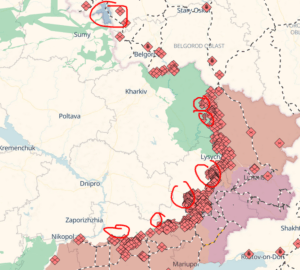
And as a review, the critical Pokrovsk to Kupiansk logistcs line, which is now very much under threat.
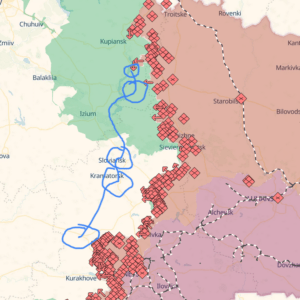
Vicious fighting at Kursk...
Now lets talk about Kursk. The map below is a screen shot from Deepstate UA as of Friday, Oct. 25. I've added red and blue to identify concerted (and concentrated) Russian counterattacks, as well as to show how Ukraine is still on the offensive in the northwest of the sector. Here there were also seen "behind the lines" skirmishes near and around Sudzha, which some believe is indicative of Russian special forces/Spetsnaz activity.
That said, the give and take in this sector is extremely fluid, and more, supposedly up-to-date maps here are often under heated debate by bloggers on all sides. That said, a harsh reality is that Ukraine has lost ground over the past weeks--keep in mind that Snagost, for example, was very much in blue the last time we spoke.
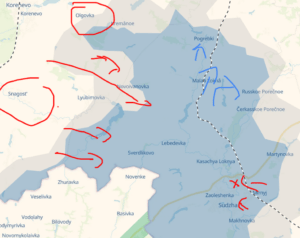
That said, the fighting is not only vicious, but it has been costly for Russia, and in fact this is still a sector in which the flexibility and natural counter-attacking-through-movement skills of the Ukrainians have been very much at play. This has been seen since Friday, with today's map of the same sector appearing as such:
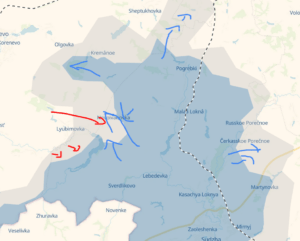
Notice the many blue counterattacks, but specifically at Novoinvanovka and in the north (following the gray, disputed areas beyond Pogrebski, which in the opinion of Yours Truly, represent not advances by raid-like attacks). That said, Novoivanovka is interesting as only days ago, the Russian drive here appeared to be the fringe of a serious advance that could cut off northern holdings. Instead, it appears that counterattacks stopped the Russians in their tracks and, according to bloggers on both sides, inflicted heavy casualties.
That said, this still remains THE critical play in the Kursk sector. Russian reinforcements are reportedly on the ground at Korenovo and near Lyubirnovka, and elite forces are believed to make up at least part of these reinforcements. Ukrainian bloggers and sources appear to believe that Ukraine can hold this point while at the same time also admitting that losing ground here will likely mean a collapse or pullout in the north. Keep in mind, however, that it is the gray area on the map that is disputed, and a pointed drive toward Novoivanovka may mean Ukraianian counterattacks from the north--i.e. from the same forces driving toward Olgonovka.
Meanwhile--and not shown here--is yet another series of attacks by Ukraine at Belgogrod, with Ukraine taking small amounts of ground there.
In short, it may be too little, too late, but the Kursk offensive is finally succeeding in truly garnering Russian attention and possibly diverting elite forces and otherwise much needed troops and supplies from the all-out grind-forward drives further south.
Kupiansk...
For the purpose of today's blog, we are going to skip the northern Kharkiv sector and the WWII-level brutality at Vovchansk, although Russian pushes at Hlyboke, for example, have put Kharkiv city within range of traditional artillery. That said, further south... the reality is nothing less than brutal. And the threat of large swaths of territory being potentially lost is growing by the day. This can be seen first in what has become the Kupiansk-Senkove cauldron.
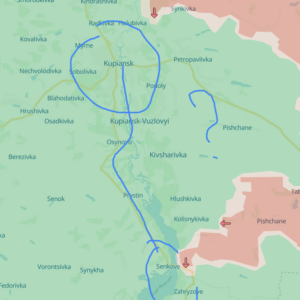
In truth, Russia has long attempted to drive toward Kupiansk, although this target has also long remained a second-tier priority, with forces routinely diverted toward other goals. Ukraine has consistently slowed down Russian forces at Synkivka, a tiny, all but non-existent village that was fought over and reported taken and retaken a number of times over the past 12 months. It does not appear at this time that Kupiansk itself can be taken (at least not in the near term), but pressure there combined with far more concentrated pressure south at Synkove and the Oskil creates a massive pocket that poses an equally massive conundrum for Ukraine.
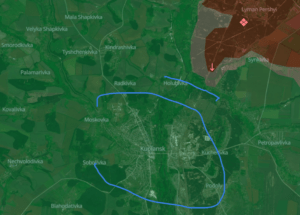
Once again, the pocket (highlighted by a blue question mark).
Here it should be said that Kupiansk is reportedly being hit hard at this time by glide bombs, which tends to be a sharp indicator of a hard Russian drive to come. Likewise, according to the ISW, Russian Spetsnaz are operating near Senkove and there are various attempts to breach the Oskil. Of the state of Ukrainian forces with the great question mark of this pocket, little is known.

Borova...
Worringly, a second cauldron may be in the works. Here at The Corners (in old and new blog form), we have long warned that Borova is a Russian target. While this target seemed to fall off the map toward the end of the summer, it never truly left the the list of Russian goals, and civilians were evacuated last week as it again appears to have become a priority.
This, unfortunately, is a very logical and very Russian move, as hitting Borova and forcing the Ukrainians back to the Oskil there will indeed create a cauldron that will be near impossible to both supply and flee.
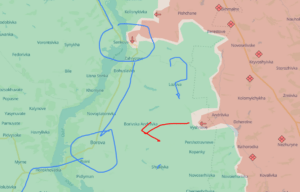
In fact, the true current danger to Borova is hard to assess at this point in time. A full two weeks ago sources for The Corners indicated that Russian special forces may have been active south of Borova, but of less doubt is that various Russian bloggers have posted evidence (again, take this always with a dose of skepticism) that Russia has attempted to hit the road to Horokhovatka and the bridge over the Oskil there. This is a very logical move, it must be admitted, although the potential of this cauldron--currently more worrying than that south of Kupiansk due to supply issues, seems to have escaped the Western press.
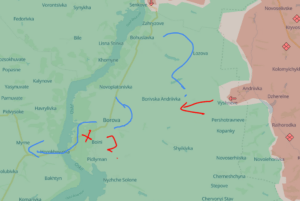
South to Pokrovsk...
Further south from Borova to Sloviansk/Kramatorsk/Kostiantynivka to Pokrovsk has not seen major Russian advances, although the grind continues, especially at Pokrovsk.
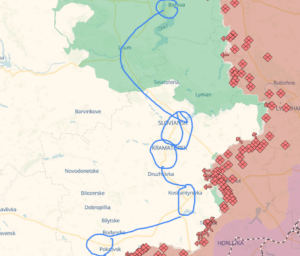
Russian proximity to Pokrovsk can be seen below. There are two factors to consider here: although Pokrovsk is holding, logistics at that supply hub should be considered disrupted, which impacts all sectors to the north. Second, as reported by the ISW back as early as Oct. 6, Russia may have lost as much as five divisions of troops and equipments at Pokrovsk since the summer.
Those are massive losses. North Koreans or not, this simply does not look sustainable. Not even for Russia.
In fact, this conflict is increasingly running similar to that of the Finnish-Russian Winter War, which took place at the beginning of the Second World War. For those unfamiliar with this conflict, here is a primer. Russia could learn something from it, especially as over the long term Finland has remained independent and strong. Unfortunately, the West could learn from it as well.
Now back to the subject. A closer look at Pokrovsk, as of Oct. 25, reveals the following map. Note that Russia is closing in also on Mynohrad, but further south there is the previously mentioned Hirnyk cauldron, which is no longer the Hirnyk cauldron, as Russia has since been confirmed to overrun that town even according to Deepstate maps.
Oct. 25 map:
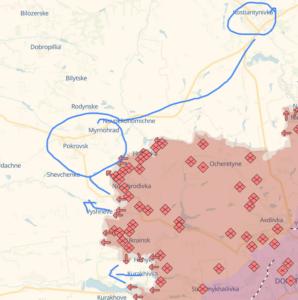
Oct. 25 map:
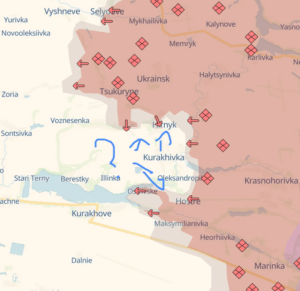
Oct. 28 map:
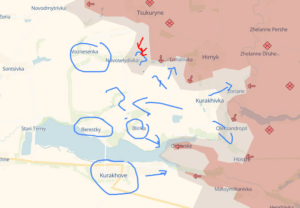
With regard to the above (and without naming details), Russian advances and the difference between the maps is obvious. That said, it appears that against all odds the Ukrainians have slowed Russian advances and are somehow holding on to the obvious pockets seen above. Likewise, they appear to have stopped Russian advances at Kurakove. Noteworthy is that the naturally wet terrain creates difficulties for Russia at least until a real winter freeze sets in.
Final thoughts...
It should also be said that further south, Russia is still pressing forward behind Vulhedar, and Russian forces are still threatening moves in Zaporizhzhia. However, while this is disconcerting, the most worrying developments still remain at Pokrovsk and further north.
Yet, there again do remain glimmers of a silver lining. While questions remain re Kursk (and the northern part of the Kursk offensive could eventually be abandoned, in the opinion of Yours Truly, in order to bolster holdings in the southern Kursk sector or even in order to try to stop Russian troops at the Oskil or Pokrovsk), it surprisingly may be soon viewed as a success. Some observers believe that Russia has lost far more troops there than advertised, and the Russian pride factor (or fear of angering Russian President Vladimir Putin) appears to be slowly kicking in, and any diversion of assets from Pokrovsk, for example, should be seen as valuable.
Likewise, there are perhaps further, more subtle implications here. Chechen forces in Kursk have been inconsequential--and Russian bloggers have heavily criticized Kadryovites there for 1) avoiding fights and 2) outright running and 3) even looting Russian stores. Mutual bickering has ensued, which comes at a bad time for Putin, who is in the process of wooing North Korea (which has gained perhaps unwanted attention too soon) and attempting to gain reinforcements from North Korea on scale.
In the meantime (and yes, North Korean advance forces are already in the fight), Russian transmissions have appeared indicating that commanders on the front 1) dislike the North Koreans (calling them "Chinese) and realize that their own officers will be needed to be pulled off of front lines to work with North Korean officers who... simply cannot speak Russian.
And no doubt North Korea, which is likely suddenly realizing the sheer cost of sending even 10,000 troops to Ukraine, is watching.
Let's hope so anyway.
Slava Ukrainii and God bless.
Preston Smith is a licensed investigator based in Gdansk, Poland. He can be reached at query@cddi.pl.
Destruction in Kupiansk in early October, courtesy of the National Police of Ukraine, CC BY 4.0 <https://creativecommons.org/licenses/by/4.0>, via Wikimedia Commons.
Maps courtesy of Deepstate UA.



Piotr Frankowski
9 miesięcy agoSlovak Minister of the Interior Matus Sutaj agreed to a settlement that states that Babis was registered against his will under the pseudonym Bures. [...]
Other countries in CEE have seen the same thing.
===
In Poland, this has become the most common way to ‘clear’ one's name.
There is even a joke about it.
Media narrative: 'I had been registered without my knowledge!'
Then the new documents come up to the light, proving that the guy knew perfectly he was an asset.
'Well, yes, but I was forced to!'
The other documents prove beyond any doubt the guy was not forced, even volunteered.
'But I didn't do any harm to anybody!'
Firstly, there was no such thing as 'irrelevant information'. Even one's breakfast menu could and had been successfully used to break people.
Secondly, as usual, another documents pop up proving the registered asset did some harm.
And usually, it ended up with:
‘So what, EVERYONE was involved somehow!
And by the way, this is hatred, a witch-hunt, those who accuse are dreaming of a bloodbath, and by the way, where is that famous Christian mercy here, eh?’
Preston Smith
9 miesięcy agoI'm quite convinced you are right.
And thanks for commenting!
Preston